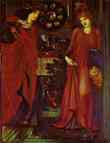Sir Edward Coley Burne-Jones Biography
Burne-Jones was born in Birmingham, the son of the owner of a small framing business. His mother died within a week of his birth. He was educated at King Edward’s School in Birmingham, and, since he was gifted at drawing, attended a government School of Design on three evenings a week since 1848. In 1853 he went to Exeter College, Oxford, with the intention of eventually entering the Church. There he met William Morris, who was to become his lifelong friend and an associate in a number of decorative projects.
As the result of seeing Rossetti’s works, Burne-Jones and Morris became late recruits to Pre-Raphaelitism. Early in 1856, Burne-Jones met Ruskin and Rossetti and managed to persuade the latter to accept him as a pupil; he and Morris left Oxford and started their artistic careers under Rossetti’s guidance. His earliest paintings are carried out in watercolor. Burne-Jones produced a number of versions of the ballad subject Fair Rosamond: Fair Rosamond and Queen Eleonor. This story was very popular with the Pre-Raphaelites and had already been used by Rossetti and Hughes.
Meanwhile the friends founded a decorating business, the company William Morris & Co. Burne-Jones was one of the directors and his prolific inspiration and rapidity of execution made him of crucial value for the firm. While his painting moved inevitably away from the influence of Rossetti and the Pre-Raphaelites, his decorative work remained a continuing contribution to the evolution of Pre-Raphaelite design. He made designs of tapestries and stained glass windows. A number of the decorative designs were turned into paintings, rather than vice versa. For example, King Mark and La Belle Iseult (1862) originated as a stained glass design and is in fact painted on top of a stained-glass carton.
From the mid-1860s, Burne-Jones's paintings become larger and more monumental, suggesting his interest in Botticelli, Mantegna and Michelangelo. Burne-Jones was an extremely hard worker and, in consequence, a very prolific artist. His Pre-Raphaelite pieces form a relatively small part of his total work. Some art historians consider Burne-Jones's Pre-Raphaelite phase an attack of ‘Pre-Raphaelite measles’, identifying him rather as a romantic, a symbolist and an aesthete. Nevertheless, the influence of Rossetti was crucial to the development of Burne-Jones’s poetic imagination. His early works, painted under the personal guidance of Rossetti from similar medieval and literary sources, or resulting from Burne-Jones’s own fascination with fifteenth century Florentine art are a valuable contribution to PreRaphaelitism. And, of course, his paintings influenced the Aesthetic movement and Art Nouveau design to a great extend. In 1890, Burne-Jones was elected to the Royal Academy, but resigned only three years later.
Bibliography
Burne-Jones. by M. Harrison & Waters B. London 1973.
Edward Burne-Jones: A Biography. by Penelope Fitzgerald. Viking Press.Reprint edition. 1990.
Burne-Jones and Williams Morris in Oxford and the Surrounding Area. by Ann S. Dean. Art Books Intl Ltd. 1996.
Painting of Europe. XIII-XX centuries. Encyclopedic Dictionary. Moscow. Iskusstvo. 1999.
Victorian Painting. by Christopher Wood. Bulfinch Press. 1999.
Edward Burne-Jones, Victorian Artist-Dreamer by Stephen Wildman. Yale Univ Pr, 1998.
Sir Edward Burne-Jones by Russell Ash. Chrysalis Books, 1997.
May and Amy: A True Story of Family, Forbidden Love, and the Secret Lives of May Gaskell, Her Daughter Amy, and Sir Edward Burne-Jones by Josceline Dimbleby. Harmony, 2005.
The Age of Rossetti, Burne-Jones, and Watts: Symbolism in Britain, 1860-1910 by Andrew Wilton, Barbara Bryant, Robert Upstone. Flammarion, 1997.
Tate British Artists: Edward Burne-Jones by David Peters Corbett. Tate, 2004.
Memorials of Edward Burne-Jones: 1833-1867 (Memorials of Edward Burne-Jones) by Georgiana Burne-Jones. Lund Humphries Publishers, 1993.
- Fair Rosamond And Queen Eleonor.

Gouache touched with gold. Private collection, UK. Read Note.
- The Legend Of St. Frideswide.

1859. Oil on cartoon for the lower half of the centre-left panel. East Window of the Latin Chapel, Christ Church Cathedral, Cheltenham Ladies College, Oxford, UK.
- Girls In A Meadow. Detail.

1860. Oil on panel. Private Collection.